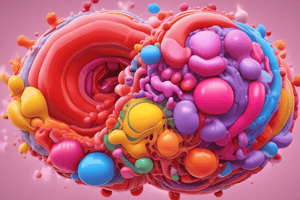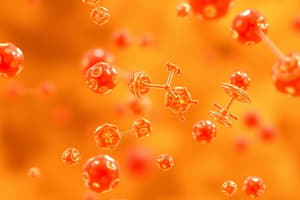Podcast
Questions and Answers
Which lipoprotein is often referred to as 'good cholesterol'?
Which lipoprotein is often referred to as 'good cholesterol'?
- High-density lipoprotein (HDL) (correct)
- Low-density lipoprotein (LDL)
- Very-low-density lipoprotein (VLDL)
- Intermediate-density lipoprotein (IDL)
A patient's total cholesterol level is 310 mg/dL. Compared to patients with cholesterol levels less than 200 mg/dL, how much greater is this patient's cholesterol?
A patient's total cholesterol level is 310 mg/dL. Compared to patients with cholesterol levels less than 200 mg/dL, how much greater is this patient's cholesterol?
- Two times greater
- Three to four times greater (correct)
- Half as much
- About the same
What is the primary mechanism of action for HMG-CoA reductase inhibitors (statins)?
What is the primary mechanism of action for HMG-CoA reductase inhibitors (statins)?
- Increasing the excretion of bile acids
- Blocking the absorption of cholesterol in the intestines
- Enhancing the breakdown of triglycerides
- Inhibiting cholesterol production in the liver (correct)
Which of the following instructions should be given to a patient taking colesevelam?
Which of the following instructions should be given to a patient taking colesevelam?
What is a common side effect associated with niacin (nicotinic acid)?
What is a common side effect associated with niacin (nicotinic acid)?
Which of the following lipid parameters is typically increased by fibric acid derivatives (fibrates)?
Which of the following lipid parameters is typically increased by fibric acid derivatives (fibrates)?
Ezetimibe is typically reserved for use only when?
Ezetimibe is typically reserved for use only when?
A patient taking a statin reports muscle pain and weakness. Which potential adverse effect should the nurse suspect?
A patient taking a statin reports muscle pain and weakness. Which potential adverse effect should the nurse suspect?
A patient is prescribed both gemfibrozil and a statin. What is a significant risk associated with this combination therapy?
A patient is prescribed both gemfibrozil and a statin. What is a significant risk associated with this combination therapy?
Based on the provided information, which herbal product necessitates caution due to potential interactions with both antidiabetic and anticoagulant drugs?
Based on the provided information, which herbal product necessitates caution due to potential interactions with both antidiabetic and anticoagulant drugs?
Which of the following is the primary function of apolipoproteins?
Which of the following is the primary function of apolipoproteins?
A patient's lipid panel shows an HDL level of 35 mg/dL. What does this value indicate?
A patient's lipid panel shows an HDL level of 35 mg/dL. What does this value indicate?
According to guidelines, what is the first line action when addressing elevated blood cholesterol levels?
According to guidelines, what is the first line action when addressing elevated blood cholesterol levels?
Which of the following instructions is most appropriate for a patient newly prescribed a statin?
Which of the following instructions is most appropriate for a patient newly prescribed a statin?
Which of the following represents a potential effect of niacin?
Which of the following represents a potential effect of niacin?
What is the primary mechanism of action for fibric acid derivatives (fibrates)?
What is the primary mechanism of action for fibric acid derivatives (fibrates)?
Which statement is most accurate regarding the use of ezetimibe?
Which statement is most accurate regarding the use of ezetimibe?
Which of the following herbal products is known to potentially enhance bleeding when taken with NSAIDs?
Which of the following herbal products is known to potentially enhance bleeding when taken with NSAIDs?
A patient taking a statin reports persistent muscle pain, fatigue, and dark urine. Which of the following conditions should the nurse suspect, and which lab value is MOST critical to assess immediately?
A patient taking a statin reports persistent muscle pain, fatigue, and dark urine. Which of the following conditions should the nurse suspect, and which lab value is MOST critical to assess immediately?
A patient with well-managed hyperlipidemia on a stable dose of rosuvastatin starts consuming large quantities of grapefruit juice daily. Assuming no other changes to their lifestyle or medication regimen, how would the patient's lipid panel MOST likely change after several weeks?
A patient with well-managed hyperlipidemia on a stable dose of rosuvastatin starts consuming large quantities of grapefruit juice daily. Assuming no other changes to their lifestyle or medication regimen, how would the patient's lipid panel MOST likely change after several weeks?
Flashcards
Antilipemic drugs
Antilipemic drugs
Drugs used to lower lipid levels; used as an adjunct to diet therapy.
Apolipoprotein
Apolipoprotein
Lipoprotein is the combination of triglyceride or cholesterol with what?
HMG-CoA Reductase Inhibitors
HMG-CoA Reductase Inhibitors
HMG-CoA reductase inhibitors, commonly known as statins, are a class of drugs primarily used to lower LDL cholesterol levels.
Evening Meal timing
Evening Meal timing
Signup and view all the flashcards
Bile Acid Sequestrants
Bile Acid Sequestrants
Signup and view all the flashcards
Myopathy
Myopathy
Signup and view all the flashcards
Aspirin or NSAIDs
Aspirin or NSAIDs
Signup and view all the flashcards
Niacin
Niacin
Signup and view all the flashcards
Fibric Acid Derivatives
Fibric Acid Derivatives
Signup and view all the flashcards
gemfibrozil
gemfibrozil
Signup and view all the flashcards
What organ is the main manufacturer of cholesterol?
What organ is the main manufacturer of cholesterol?
Signup and view all the flashcards
What are lipids?
What are lipids?
Signup and view all the flashcards
Before drug therapy is considered, what should happen?
Before drug therapy is considered, what should happen?
Signup and view all the flashcards
How are HMG-CoA reductase inhibitors administered?
How are HMG-CoA reductase inhibitors administered?
Signup and view all the flashcards
Cholesterol absorption inhibitor
Cholesterol absorption inhibitor
Signup and view all the flashcards
A common side effect of Niacin
A common side effect of Niacin
Signup and view all the flashcards
Key aspects of Flax
Key aspects of Flax
Signup and view all the flashcards
Colesevelam (Welchol)
Colesevelam (Welchol)
Signup and view all the flashcards
Study Notes
Triglycerides and Cholesterol
- Lipids are water-insoluble fats that require binding to apolipoproteins for transport.
- The liver is a key organ for lipid metabolism and cholesterol production.
- Lipoprotein is a combination of triglyceride or cholesterol with apolipoprotein.
- Very-low-density lipoprotein (VLDL) is produced by the liver and transports endogenous lipids for the cells.
- Low-density lipoprotein (LDL) and High-density lipoprotein (HDL) are present
- HDL is responsible for "recycling" cholesterol and is termed "good cholesterol."
Cholesterol and Coronary Heart Disease Risk
- Low HDL levels are less than 40 mg/dL.
- Total cholesterol levels of 300 mg/dL is three to four times greater than levels in patients with levels less than 200 mg/dL.
- Increased cholesterol leads to an increased incidence of death.
Treatment Guidelines
- Antilipemic drugs are used to lower lipid levels as an addition to diet therapy.
- Drug choice depends on the patient's lipid profile.
- Antilipemics are recommended for those with clinical atherosclerotic cardiovascular disease.
- Antilipemics are recommended for those with LDL cholesterol ≥ 190mg/dL.
- Antilipemics are recommended for diabetics aged 40-75 with LDL levels between 70 to 189mg/dL without CVD.
- Antilipemics are recommended for those without CVD or diabetes but with LDL levels between 70 to 189mg/dL and high CVD risk factors within 10 years.
- Non-drug approaches should be attempted for at least 6 months before considering drug therapy.
Antilipemics
- Classes of antilipemic drugs include HMG-CoA reductase inhibitors (HMGs or statins).
- Bile acid sequestrants are a class of antilipemics
- Niacin (vitamin B3 or nicotinic acid) is a type of antilipemic
- Fibric acid derivatives (fibrates)
- Cholesterol absorption inhibitors (Zetia) can be used as antilipemics
- Herbal medications can be used as antilipemics
HMG-CoA Reductase Inhibitors
- HMG-CoA reductase inhibitors (HMGs, or statins) are potent LDL reducers
- Examples of HMG-CoA reductase inhibitors include pravastatin (Pravachol), simvastatin (Zocor), atorvastatin (Lipitor), fluvastatin (Lescol), rosuvastatin (Crestor), and pitavastatin (Livalo).
- HMG-CoA reductase inhibitors should be administered orally in the evening with food.
- Baseline cholesterol, HDL, LDL, triglycerides, as well as renal and liver function tests should be monitored before and periodically during therapy.
- Effects may take 6-8 weeks to appear.
HMG-CoA Reductase Inhibitors Action and Side Effects
- HMG-CoA reductase inhibitors inhibit HMG-CoA reductase, used by the liver to produce cholesterol.
- HMG-CoA reductase inhibitors decrease the rate of cholesterol production.
- First-line drug therapy for hypercholesterolemia
- HMG-CoA reductase inhibitors reduce LDL levels, increase HDL levels, and reduce triglycerides.
- HMG-CoA reductase inhibitors can cause mild, transient GI disturbances, rash, headache, or myopathy (muscle pain), potentially leading to rhabdomyolysis.
- HMG-CoA reductase inhibitors can cause elevated liver enzymes or liver disease and peripheral neuropathy.
HMG-CoA Reductase Inhibitors Interactions
- HMG-CoA reductase inhibitors interact with oral anticoagulants and various drugs, including erythromycin, antifungals, verapamil, diltiazem, HIV protease inhibitors, and amiodarone.
- Grapefruit juice delays metabolism of statins.
Bile Acid Sequestrants
- Bile acid sequestrants may be used with statins as second-line drugs
- Examples of bile acid sequestrants include cholestyramine (Questran), colestipol hydrochloride (Colestid), and colesevelam (Welchol).
- Colesevelam (Welchol) is available in tablet form.
- Cholestyramine (Questran) is supplied as a powder.
- Colesevelam (Welchol should be taken orally in tablet form with food and 8oz of water, and not with other medications.
Bile Acid Sequestrants Action and Side Effects
- Bile acid sequestrants act by preventing the reabsorption of bile acids from the small intestine, which are needed for cholesterol absorption.
- Bile acid sequestrants can cause constipation, heartburn, nausea, belching, and bloating which can get better over time.
Niacin
- Niacin is also known as Vitamin B3
- Niacin is effective, inexpensive and often used in combination with other lipid-lowering drugs
- Niacin will decrease triglycerides, total serum cholesterol, and LDL levels, and increase HDL levels
Niacin Action and Side Effects
- Niacin increases activity of lipase, which breaks down lipids
- Niacin reduces the metabolism of cholesterol and triglycerides
- Niacin will cause flushing (caused by histamine release), pruritus, GI distress, hyperglycemia, and hepatotoxicity
Fibric Acid Derivatives
- Fibric acid derivatives (fibrates) include gemfibrozil (Lopid) and fenofibrate (Tricor)
- Fibric acid derivatives decrease triglyceride levels and increase HDL.
Fibric Acid Derivatives Action and Side Effects
- Fibric acid derivatives activate lipase, which breaks down cholesterol.
- Fibric acid derivatives suppress the release of free fatty acid from adipose tissue.
- Fibric acid derivatives inhibit the synthesis of triglycerides in the liver.
- Fibric acid derivatives increase the secretion of cholesterol in the bile.
- Fibric acid derivatives may cause abdominal discomfort, diarrhea, nausea, blurred vision, headache, increased risk of gallstones, prolonged prothrombin time, abnormal liver studies, and myopathy.
Fibric Acid Derivatives Interactions
- Fibric acid derivatives will interact with oral anticoagulants and statins
- The risk for myositis, myalgias, and rhabdomyolysis is increased when taking fibric acid derivatives
- Fibric acid derivatives can cause decreased hemoglobin levels, hematocrit value, and white blood cell counts
- Fibric acid derivatives may lead to increased activated clotting time, lactate dehydrogenase levels, and bilirubin levels
Cholesterol Absorption Inhibitor
- Ezetimibe (Zetia) is a cholesterol absorption inhibitor
- Ezetimibe is often combined with a statin drug
- Ezetimibe is recommended when patients have not responded to other therapies
- Ezetimibe can lower total cholesterol, LDL, and triglyceride levels, and can increase HDL levels
Cholesterol Absorption Inhibitor Action and Side Effects
- Cholesterol absorption inhibitors inhibit the absorption of cholesterol secreted in the bile and from food
- Cholesterol absorption inhibitors can cause hepatitis and myopathy
- Cholesterol absorption inhibitors are contraindicated in patients who have mild to severe liver disorders
Herbal Products: Omega-3 Fatty Acids
- Omega-3 fatty acids are a herbal product that are used to reduce cholesterol and may cause rash, belching, and allergic reactions
- Omega-3 may have potential interactions with anticoagulant drugs
Herbal Products: Garlic
- Garlic is a herbal product that is a lipid reducer but can cause adverse effects of dermatitis, vomiting, diarrhea, flatulence, and antiplatelet activity
- Garlic can interact with warfarin and diazepam, and may enhance bleeding when taken with NSAIDs
Herbal Products: Flax
- Flax is a herbal product where both the seed and oil of the flax plant are used to lower cholesterol
- Flax may cause diarrhea and allergic reactions
- Flax may interact with antidiabetic and anticoagulant drugs
Nursing Implications
- Contraindications include biliary obstruction, liver dysfunction, and active liver disease
- Baseline liver function studies should be obtained
- Patients on long-term therapy may need supplemental fat-soluble vitamins (A, D, K)
- Take with meals to decrease GI upset
- Powder forms must be taken with a liquid, mixed thoroughly but not stirred, and NEVER taken dry
- Other medications should be taken 1 hour before or 4 to 6 hours after meals to avoid interference with absorption
- To minimize adverse effects of niacin, start on a low initial dose and gradually increase it, and take with meals
- Small doses of aspirin or NSAIDs may be taken 30 minutes before niacin to minimize cutaneous flushing
- Patients should be informed that these drugs may take several weeks to show effectiveness
- Patients should report persistent GI upset, constipation, abnormal or unusual bleeding, and yellow discoloration of the skin
- Monitor for adverse and therapeutic effects, including liver enzyme studies, reduced cholesterol, and reduced triglyceride levels
SDOH
- Zocor costs $195.65 without insurance.
- Generic lipitor costs $126.99 without insurance.
- Cholestyramine costs $148.99
- Lipid panel can range from $200 to $843 without insurance and $19 with private insurance or Medicare
Studying That Suits You
Use AI to generate personalized quizzes and flashcards to suit your learning preferences.




